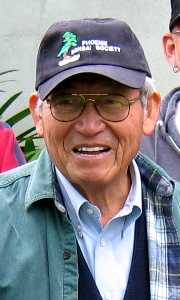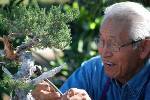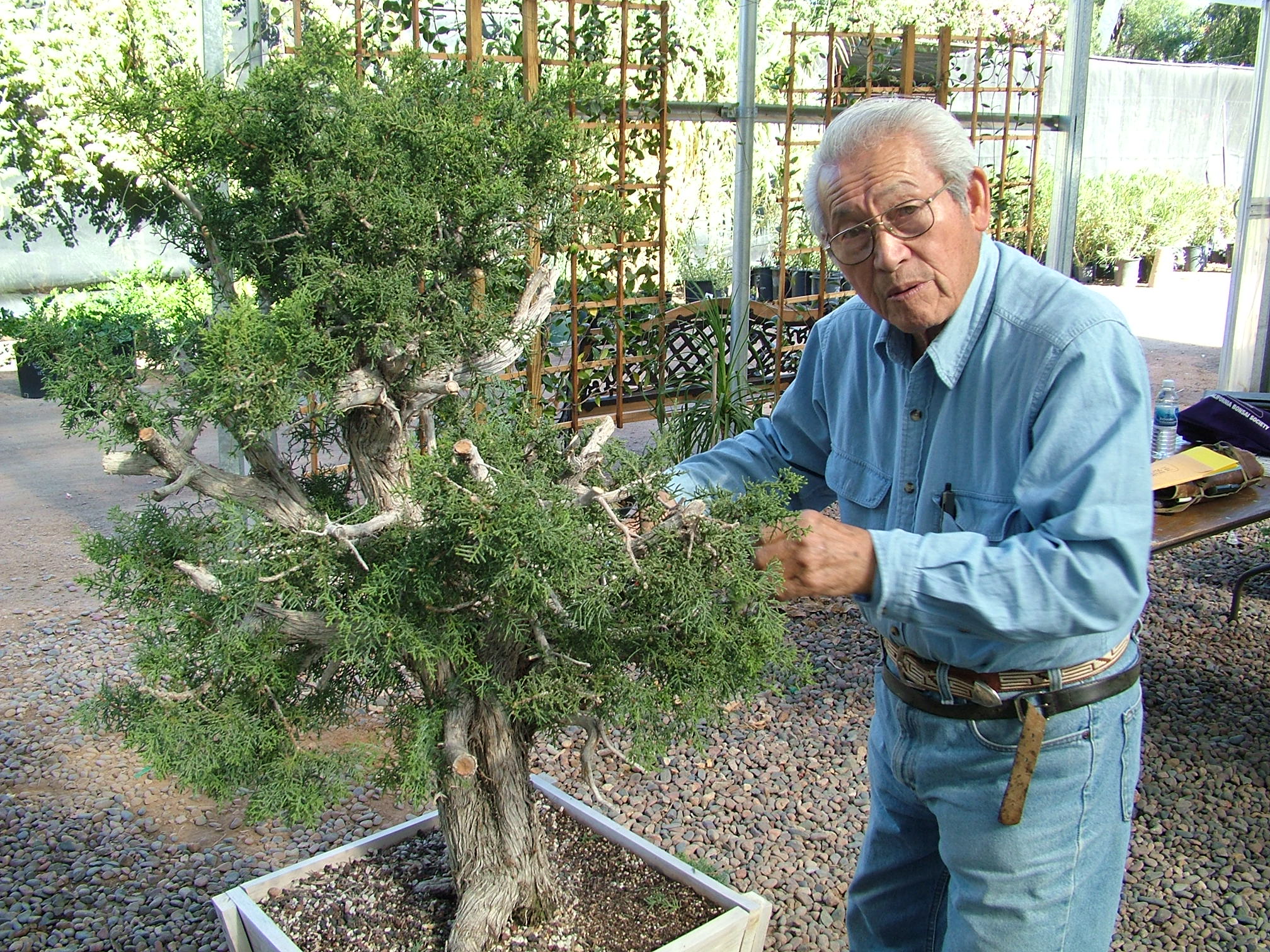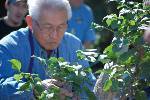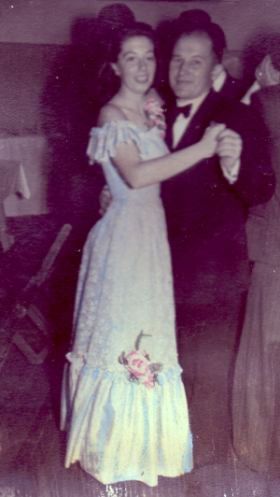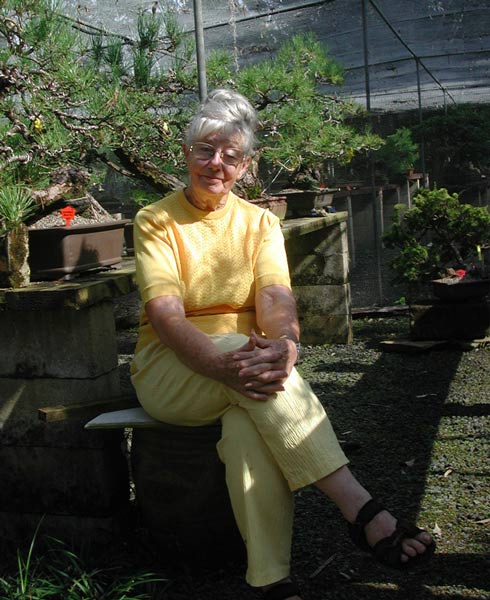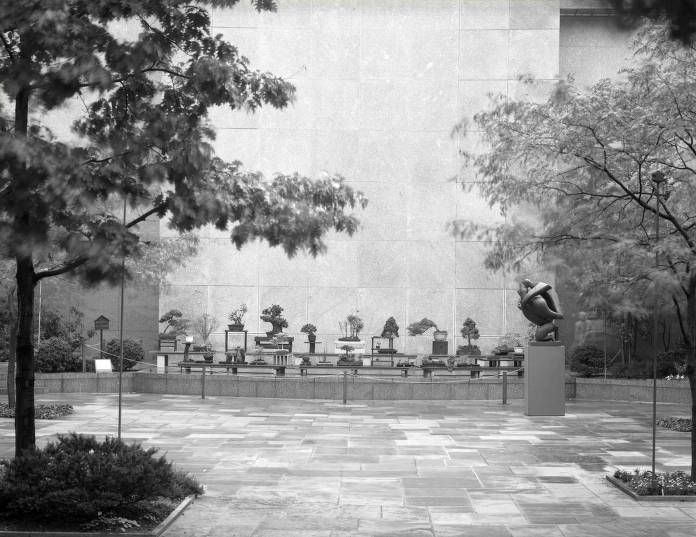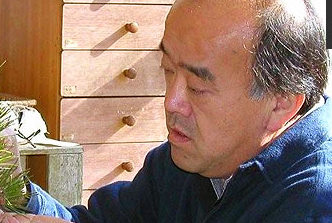| 21 |
|
||||
| 22 |
1944 -- Furukawa Masahiro was born in Nagasaki, Japan. [He would go on to be
an influential teacher of saikei in the Pacific Northwest region of the United States.]
(Andrew Robson in Facebook post on November 21, 2024)
SEE ALSO: Jan 5, Nov 22
1970 -- The episode "Mr. Osaki's Tree" aired for the CBS-TV series "Family Affair." California teacher John Naka served as consultant for this episode about an old and sick Japanese man (Teru Shimada) going back to his country to die there. He gives his bonsai to Jody (Johnny Whitaker) who believes Mr. Osaki's health depends on the tree's health. [Naka, Bonsai Techniques, pg. 258; http://dawnrain.com/BrianKeith/contenus/fa-episodes.asp?episodeID=108&Submit=selected+episode+details ; http://us.imdb.com/Name?Shimada,+Teru ] |
||||
| 23 |
1981 -- Fifteen individuals met at Fuku-Bonsai in Kurtistown, Hawaii
to form the Big Island Bonsai Association (BIBA) as a non-profit group
of individuals dedicated to the promotion, advancement, and fellowship
of bonsai. It began a three year project consisting of the "Revitalization
of Bonsai on the Big Island" that included forming new clubs, "bonsai day"
promotional events in various areas, the first All-Big Island Bonsai Show
at Wailoa Center in Hilo, and a 10-session bonsai course held over 10 weeks
in Hilo, Kamuela, and Kona. The entire project was co-sponsored by
the University of Hawaii at Hilo College of Continuing Education and Community
Service, University of Hawaii at Manoa Cooperative Extension Service, State
of Hawaii - Wailoa Center, County of Hawaii Department of Parks and Recreation,
and various business sponsors and individuals. [The project would
be an outstanding success and in 1984 BIBA would be honored with the Hawaii
State First Lady VIP (Volunteers in Paradise) Award. And on the occasion
of the 20th All-Big Island Show at Wailoa Center in 2001, certificates
of appreciation were presented to those members that were still active
and four of the original group were asked to create a formal bonsai niche exhibit.]
("Big Island Bonsai Association & All-Big Island Big Show,"
http://www.fukubonsai.com/5a12.html
)
2009 -- Singapore bonsai master Boh Chit Hee died at the age of 73. [His collection of thirty other large, 50 medium, 400-500 small and mini-sized bonsai would then be cared for by his family.] (E-mails to RJB from Mo Zhuang Ze on 2 and 6 Apr 2012) SEE ALSO: May 3 2012 -- After several years of petitions by our fellow enthusiasts, a set of five postage stamps featuring bonsai were issued today by the U.S. These were in the format of Forever® stamps, which are always equal in value to the current First-Class Mail one-ounce rate. SEE ALSO: Jan 29, Feb 3, Feb 16, Mar 1, Mar 27, Mar 31, Apr 3, Apr 6, Apr 18, May 6, May 29, Jun 16, Jul 20, Aug 20, Aug 22, Sep 22, Oct 1, Oct 4, Dec 9. 2017 -- Naokichi Nozaki, 94, of Keaau, died at his home. (Born in Ola'a, Territory of Hawaii about 1923, he was a retired mechanic for the former Hamakua Sugar Company and member of Taishoji Soto Mission, Taishoji Bonsai Club, Big Island Bonsai Association, Lehua Bonsai Club, Kamana Bonsai Club, and Keaau Village Kumiai. He had been recognized in 2009 by the Japanese Community Association of Hawaii as a Cultural Treasure for his contribution in perpetuating the Japanese Culture of Bonsai. He had been sensei at two county Hawaii centers.) (per phone call to RJB on March 5, 2017 by Bill Newton, a long-time bonsai teacher -- and two decade associate of RJB -- who was a member at the centers and who was chosen to replace Nozaki about a week before the sensei died; "Naokichi Nozaki," http://www.dodomortuary.com/fh/obituaries/obituary.cfm?o_id=4115762&fh_id=11845) |
||||
| 24 |
|
||||
| 25 |
1967 -- As a Supplement to Farmer's Weekly, Bloemfontein, there was published Capel Hemy's 20 page
How to Grow Miniature Trees,
Full instructions for practising the ancient art of BONSAI. With 17 photographs and seven line
drawings, it provided the first detailed in-print instructions in the country. It featured some info on
Becky Lucas, who was the Grand Dame of bonsai in South Africa. Bonsai had first become popular in that country
in the 1960's, mainly through the efforts of Mrs. Lucas of St. James, Cape Town, who had already been growing the
wee trees since 1939. Becky and her husband were on a visit to Japan in 1954 when she became engrossed in
the culture of bonsai. So interested was she that she went back to Japan in 1957 where she spent a year or
two taking classes with Japanese masters. When she returned to South Africa, she practiced the art of bonsai
and started to teach other people. She was extremely enthusiastic and passed this enthusiasm onto potential
bonsai growers. The South African Bonsai Society was founded in Cape Town in 1960, with Becky as the main
driving force. Meetings were held at her home in Boyes Drive in St James. True to the Japanese culture
she was very disciplined in her approach to bonsai and expected the same from all the members. Members were
expected to attend all meetings (there was trouble if you missed one) and never be late (one member says it was
like being in the army). The meetings were quite something. Tea would always be served during or after
these gatherings. Over the years, Becky built up an impressive collection of miniature trees, and she was
remembered for having over 300 potted specimens on her tiny patio. Boyes Drive is just to the east and south
of the Muizenberg Mountains, the southern end of the wide crecent of mountains south of Cape Town. This is
at the base of the Cape Peninsula, which holds
Table Mountain National Park on the
southwest corner of the Cape. The road rises up to about 30m above sea level, and the land beyond it rises
quickly to 200m and then to 400m+. St. James, Western Cape, is a small village on the coast about halfway
down Boyes Drive, overlooking False Bay to the east and south. St. James, between
Muizenberg and
Kalk Bay, is about a 25 minute (not rush hour) drive down from Cape
Town. Becky's lovely home overlooking the seahouse was right at the top of Boyes Drive, across from the
unspoiled mountainside. There were some expeditions into the mountain to scout for indigenous species that
were suitable for bonsai. Members observed these trees, but they did not dig. [The summer of 1967 would see a three-month visit to Japan by Becky. This would include the nurseries of Kyuzo Murata, Nobukichi Koide, and Eiji [sic] Yoshimura, as well as instruction under Toshio Kawamoto. Her article about this, derived from her letters and reports, would be published in BCI's Bonsai Magazine the following March ("A Summer in Japan," Vol. VII, No. 3, pp. 8-9). In 1970 Becky would have differences of opinion and make accusations which were possibly libellous against some growers. She had very clear ideas of what she wanted and had no time for those with different views or opinions. That year four members of the South African Bonsai Society, who were not satisfied with its "politics," would break away to form the Cape Bonsai Kai. Bob Richards would be the first chairman (president) and Bernard Coetzee the vice chairman. Becky would then travel to other cities in South Africa such as Durban, Johannesburg, Port Elizabeth, and East London, creating interest and starting branches of the Bonsai Society (all named "Bonsai Society of South Africa -- [the city's name] Branch.") In the late nineteen-seventies or early nineteen-eighties Becky would suffer a severe stroke and be left handicapped. She would move to Johannesburg and her collection of trees would be presented to Stellenbosch University, where they can still be seen in the Arboretum (officially known as Hortus botanicus), in a bonsai-en specially constructed for them. Wim Tijmans, curator at the time and member of the Cape Town club, would have some trouble explaining the significance of this gift to the powers-that-be at the university, which would include the head of the Department of Botany. The en would be built in the 1.8 hectare botanical garden. The Japanese consul in Cape Town would perform the official handing over and the opening of the en. The Japanese women who attended would be in traditional dress. [Becky would die sometime in the nineteen-eighties. She had been a very generous and hospitable person, and she apparently never sold a tree; she would rather give it to you. Her house was always open to people wanting advice and assistance with trees. People who knew Becky say she was a dignified and gracious lady. Becky was not one for half measures. She traveled through the country, teaching bonsai and establishing clubs as far as she went. Many clubs have this strong-minded person to thank for their existence. [The Boland Bonsai Kai would be situated in Stellenbosch (about 30 miles E of Cape Town and about as far NE of St. James) and its monthly meetings would be held in the Botanical Garden of the university. The club members would maintain the collection as there was no-one on the garden staff who had the knowledge. While there had been some bonsai in the garden since at least 1968, it wouldn't be until the bonsai collection of Mrs. Becky Lucas was donated in the 1970s that a significant number of trees would be there. The collection would consist of some of the classic Japanese bonsai species, among them Japanese black pine and Acer palmatum, as well as some less traditional species. The oldest trees in the collection are from her and date back to the 1940s. The bonsai-en, which includes the collection, would be moved in 2010 from a very shady place under the oaks to a more appropriate sunny area. The trees would then be in much better shape and the members would slowly get them back from the tall and lanky look they would have acquired during the years of neglect in the shade. This move would be been financed by donations from companies and foundations. [With about 300 bonsai trees by September 2012, the Botanical Gardens of Stellenbosch University would for the first time have an official name: The Western Cape Bonsai Heritage Collection. The name would be registered with the South African Botanical Society. Besides having trees designed by the late Becky Lucas and the Rev. Gerjo van der Merwe (one of the first enthusiasts to grow indigenous bonsai from seeds in South Africa, including wild olive trees, Kei apple trees and Chinese elms, among others), since March 2012 the trees belonging to the late Louis Nel of Pretoria would become the new focus point of the collection. His daughter Zonia, who would live in Stellenbosch, would then donate the extensive collection begun in 1974 to the Botanical Gardens on permanent loan. The first African tree in the collection to have been adapted for bonsai was a Natal fig (Ficus natalensis) designed by Ian Ross in 1948. In addition to South African visitors, the collection would also be popular among people from Britain, Germany, the Scandinavian countries and the Netherlands.] 
"A collection of miniature trees at the home of Mrs. Becky Lucas, chairman of the Bonsai Society of South Africa
(Personal e-mail to RJB from Coenie Brand, 7 Dec 2010; personal e-mail to RJB from Lionel Theron, 17 Feb 2011;
Davis, Doreen "The Cape Bonsai Kai," Bonsai Journal, ABS, Vol. 12, No. 3, Fall 1978, pg. 59; Cape
Bonsai Kai was welcomed in Bonsai Magazine, Vol. IX, No. 7, September 1970, BCI, pg. 7, with mention of its
upcoming show October 3 and 4 on pg. 15; The 1970 Index at the end of the March 1971 issue (pg. C) notes that in
Vol. IX, No. 2, pg. 13 Sustaining Members and Donors included "Becky Lucas, Cape Town, South Africa - Wim. Tijmens,
Cape Town, South Africa."; "Bonsai collection in SU Botanical Gardens gets official name," Sept. 6, 2012,
https://web.archive.org/web/20141114094551/http://blogs.sun.ac.za/news/2012/09/06/bonsai-collection-in-su-botanical-gardens-gets-official-name/;
Sax, Miles S. and Willem Pretorius
"The
Bonsai Collection of Stellenbosch University Botanical Garden," Arnoldia 73/2, October 2015, pp. 28-29,
31; Theron, Lionel
"A brief
history of Bonsai in South Africa") SEE ALSO: Apr 20, Nov 21, Nov 23
(Cape)." (Photo from Capel Hemy's 1967 How to Grow Miniature Trees, pg. 19) 1968 -- The first meeting of the Indianapolis Bonsai Club was held today with 18 charter members Bev Oliver was elected president and programs were planned for the rest of the year. (In the Spring of 1965, she had set up a bonsai booth at the Indianapolis Flower and Patio Show. Having been transferred from the Cleveland area where Bev had been exposed to the Cleveland Bonsai Society, she was determined to find others in the area who shared her interest. On a Sunday in October, 1967, the Indianapolis Star ran an article "Interest In Bonsai Horticulture Stirs Plans For Forming Club" written by one of the local Women's Editors. Anyone interested in Bonsai was urged to write or call Mrs. Oliver. Response was very good, and finally, on January 12, 1968, Sybil Mead, Betty Pierce, and Bev Oliver met as a self-appointed board to start the club.) [The first IBC Show would be held on May 23 at the Glendale Shopping Center Auditorium, in conjunction with having Lynn Perry Alstadt as lecturer and demonstrator. About 75 people attended. The following day, Lynn gave a workshop limited to members only.] ("Indianapolis Bonsai Club, Club History," http://www.indybonsai.org/history.html; Bonsai Magazine, BCI, Vol. XII, No. 7, Sept 1973) ) 2007 -- Chris J. Yeapanis of Fairfax, Virginia, died. (He was born in 1948. He had been a National Bonsai Foundation Board Member for many years and he also served as its Treasurer. He was active in the Potomac Bonsai Association (PBA), a founder of the Potomac Viewing Stone Group and a regular contributor to Clippings, the PBA monthly newsletter. He served as President of the Northern Virginia Bonsai Society, President of the Potomac Viewing Stone Group, and Educational Vice President of PBA. He was one of the original organizers of the 5th World Bonsai Convention in Washington D.C. in 2005. Chris had an extensive network of bonsai and viewing stone friends on both coasts. He was married to his long-time wife Betty.) ("Chris Yeapanis 1948-2007," NBF Bulletin, Spring 2007, Vol. XVIII, No. 1, pg. 2; photo from Alan Walker, also used in this NBF Bulletin and also in http://www.vlbanting.com/nationalbonsaimusem.htm) |
||||
| 26 |
1927 --
Ben Oki was born in Sacramento, CA when his father
lived the the States. [Six years later Ben would go to Japan for his formal education.
Incredibly, he would live in Hiroshima and be fishing on a river away from town on August 6, 1945 when the
atomic bomb was dropped on Hiroshima. He'd manage to survive the atomic blast but his brother would not.
Ben would return to California in 1950 after graduating from Matsu Moto Business School. He would marry
a lady named Sadako, have two children, and begin a landscape business. In 1958 he would start studying
bonsai with teacher John Naka, the latter recognizing the former's keen eye and
talent with the art. Ben would assist
John
in his demonstrations, travel with him beginning in 1973, and become a sought-after teacher in his own
right. He would be best recognized for his rugged free-form style, fine detail work, and whirlwind wiring
technique. He would be labelled "the fastest bonsai wirer in the west." Ben would become a member of
numerous clubs in the U.S., and an honorary member of clubs in Colombia and South Africa. In 1989, Los
Angeles Consul General of Japan
Seki Hiromoto would
honor Ben with a prestigious recognition of the teacher's
collected California juniper, "Ryu No Ma" ("Dancing Dragon"). The tree would become a part of the North
American Collection at the National Bonsai and Penjing Museum, U.S. National Arboretum in Washington, D.C. in
1991. Ben would also have a 35-year-old hackberry displayed as part of the
Pacific Rim
Bonsai Collection of Weyerhaeuser in Tacoma, WA. Since 1984, Ben would lead "Ben Oki's Japan Bonsai
Tour" to visit gardens, nurseries, and pottery shops. Ben's design work would include the garden of screen
star Cybill Shepherd in Tennessee, and others in the
Pacific Islands and South America. Ben would become curator of the Bonsai Collections at the
Huntington Library and Botanical
Gardens in San Marino, CA.]
("Ben Oki -- A Biography," Bonsai, BCI, Sept/Oct 1991, pg. 33; "Puget Sound Bonsai Association Guest Artist for November 24 & 25, 2002: Ben Oki," http://www.psba.8m.com/oki.html; Facebook posting by Rob Kempinski 02/25/18; left-hand image © 2005 Phoenix Bonsai Society; middle image, top right, and bottom right by John Hardy © 2008 Phoenix Bonsai Society; middle right image by Jamie Sims © 2006 Phoenix Bonsai Society) SEE ALSO: Jan 10, Feb 23, Apr 2, Jul28 1937 -- Reiner Goebel was born. [He would go on to be one of the old guard of the Toronto bonsai scene.) ("Reiner Goebel," memorial at TBS website, Jan 30, 2018) SEE ALSO: this date 2018
1939 -- Dan Robinson was born in Seattle, WA. [Thirty-nine years later while
demonstrating for the first time at a national convention (Portland, BCI '78), he would transform an upright
Ponderosa Pine into a cascade -- using a selection of power tools. This radical approach would be vilified
by some in the bonsai community, but the BBG's Frank Okamura would comment at the convention that Dan was "the
Picasso of Bonsai." Many -- including some of Dan's critics -- in this country and elsewhere would adopt
similar methods for creation within a dozen years. Collecting trees across this continent, his undisputed
artistic talents would always be tempered with a passion for "bringing them back alive." Dan would be hailed
as the Father of American Bonsai as he further broadened our horizons with "
Focal Point Bonsai Design." This would
challenge the traditional triangular design for all trees by shaping the foliage and branches to surround and
frame the area of greatest visual value in our arboreal compositions. An October 1989 Smithsonian
magazine article by Ogden Tanner, "Bonsai: a way of looking at trees with different eyes," brought Dan's story
to the general public. His detailed biography would be published in 2010, Gnarly Branches, Ancient Trees:
The Life and Works of Dan Robinson, Bonsai Pioneer (Nara Press) by Wil Hiltz, with photographs by Hiltz and
Victrinia Ridgeway. The first episode of the Bonsai Time Podcast from early March 2022 is a two and a
quarter hour-long
"Conversation
with Dan Robinson". An iconic two-part conversation with Ryan Neil in May can be heard
here and
here. A wonderful 3-part video tour of
Dan's Elandan Gardens by David Easterbrook was published the next year,
"The Gnarly Bonsai Philosophy of Dan Robinson,"
"Ancient Trees and Ocean Breezes With Bonsai Artist Dan Robinson,"
and "Final Tour of Elandan Gardens With Bonsai Master Dan
Robinson." Many factoids from his decades of field observations of the growth patterns of trees in the
wild are scattered throughout these videos.] 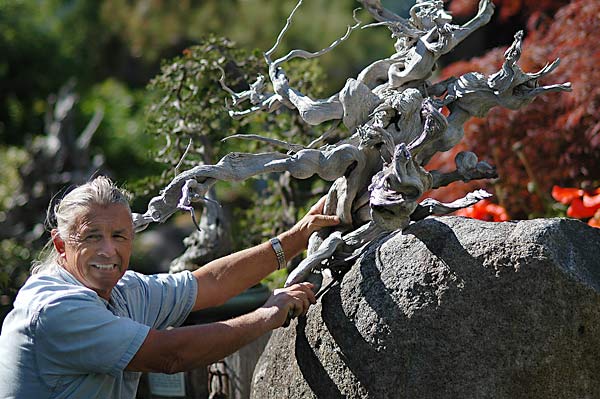
Dan Robinson, 06/17/06, by Walter Pall
(RJB telephone conversation with Diane Robinson, Apr. 15, 2000;
www.elandangardens.com
website) SEE ALSO: Nov 5
(Photo courtesy of Alan Walker, 05/11/07)
1996 -- The
Dai Ichi Bonsai Kai Web site
was established by Rick Wagner. With the club President's
permission, a homepage for DIBK was established at Geocities, a free
homepages Web service. At the time, not only was it the first
bonsai club Web site, it was the first bonsai Web site (as opposed to newsgroup) of any
kind. A few weeks after it was established, a search using Yahoo!
on the keyword "bonsai" found only the DIBK homepage. (The club
had been organized in early 1986 to serve the South Bay (southern Santa
Monica Bay) area of Los Angeles County.)
("Club History,"
http://web.archive.org/web/20071218214548/http://www.gsbf-bonsai.org/daiichibonsaikai/history.html
) SEE ALSO: Apr 9, Aug Also
(Around 1990, the TBS membership voted for applying to Bonsai Clubs International (BCI) to hold one of its conventions. Reiner was conscripted to act as Chairman of the Convention Committee and (what else?) Treasurer. The application was successful and the TBS was awarded the convention for July 1997. To facilitate smooth communication, Reiner decided to join the Board of Directors of BCI, where he served as Recording Secretary. He later also served as Director and Treasurer of the American Bonsai Society (ABS). (A White Cedar (Thuja occidentalis) from about 1750 was collected by Reiner along the exposed rocky north shore of Lake Huron and trained by him into a slant style during a Memphis, TN workshop with Masahiko Kimura. The tree was subsequently donated to the Weyerhaeuser Company's Pacific Rim Collection, becoming Specimen No. 239. For any thuja or larix in the USA that was "collected in Canada some time ago," there is a fair chance that it was collected by Reiner Goebel or John Biel in the early '90s in preparation for the '97 convention. John and Reiner were two of the old guard of the Toronto bonsai scene. They both taught at an Internal Bonsai Arboretum symposium in 1991. John would teach at another IBA in 2003 as well as at that year's BCI convention, after doing a demonstration and workshop at the ABS convention in 2002. John also had taught for the Midatlantic Bonsai Societies in April 1997. Reiner was later doing well, but as of 2015 was completely retired from bonsai. He had been selling off his trees over the last few years.) Reiner left behind his wife of 47 years, Mary-Gayle, his son Matthias (Dirk) and his daughter Nicola, his sister Ursula Jeissmann in Germany, as well as many friends, business associates and other bonsai enthusiasts. 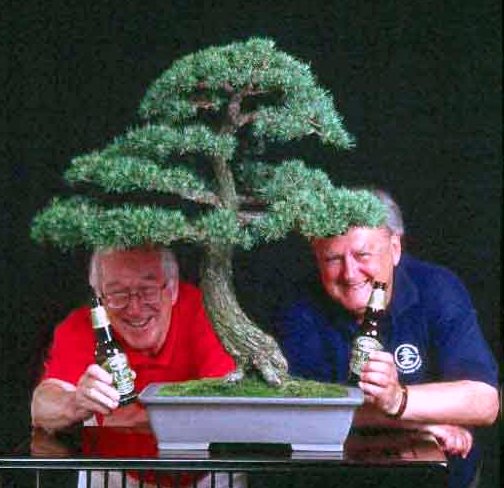
Reiner Goebel and John Biel. 06/04
("RIP REINER GOEBEL," IBC posting Jan 30,
2018 by cvbrs; "Reiner Goebel," memorial at TBS website,
Jan 30, 2018; "Solo Photo," Conejo Valley Bonsai Society Newsletter,
January
2010 issue, pg. 4; "Major
changes for an old tamarack," posting by amkhalid to Bonsai Nut, Jul 22, 2016;
"Eighteen Year Larch Progression," by Lakeshore Bonsai)
SEE ALSO: Jan 27, Mar 31, May 16, May 29, Dec 11
(Photo courtesy of Alan Walker, 05/11/07) |
||||
| 27 |
1949 -- Qingquan Zhao was born in Yangzhou, Jiangsu Province, China.
[He would become seriously involved with
penjing around age twenty when his father would introduce him to an old friend, penjing researcher Xu Xiaobai.
Learning also from other old masters from various parts of China, he would spend time in the traditional studies of
painting and poetry. In the 1970s he would begin developing the "Water-and-Land" style of penjing to supplement the
eight hundred year-old traditional forms of "Tree Scene" and "Mountain-and-River Landscape." He
would start to co-author what would be several texts in Chinese in 1981 before his own work, Penjing: Worlds of Wonderment,
A Journey Exploring an Ancient Chinese Art and Its History, Cultural Background, and Aesthetics with his long-time
translator Karin Albert would be published in English in 1997. In 1992 he would make his first Western appearance
demonstrating before the Bonsai Societies of Florida Convention; the following year before the second World Bonsai
Friendship Federation Convention, also in Florida and in conjunction with BCI and ABS. A third generation
enthusiast, "Brook" (as he would be known to the West) would be Vice-President of the Association of Penjing Artists
of China.]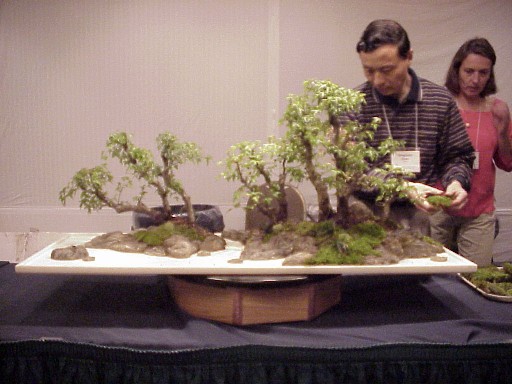
Brook Zhao with interpreter Karin Albert, 04/2001
(Karin Albert personal e-mail to RJB, July 15, 2002; "A Chinese Penjing
Artist Visits America" by Karin Albert,
Bonsai Magazine, BCI, Vol. XXXI, No. 4, July/August 1992, pp. 11-13; Hu, Yunhua
Chinese Penjing, Miniature Trees and Landscapes
(Portland, OR: Timber Press; ©1987 Wan Li
Books Co., Ltd., Hong Kong), pg. 59 ) SEE ALSO:
Mar 15, Sep 25
(Photo courtesy of Alan Walker, 05/11/07) 1952 -- Václav Novák was born in Libochovice, Czechoslovakia, about 28 miles/46 km northwest of the capital of Prague (Praha). [He would complete his studies on water transport at the technical college, and then work as a machine operator on boat on the Labe (aka Elbe) river. He would then work in the glass factory in Libochovice and later on the boat again. Václav's interest in bonsai growing arose after the lecture of Hideo Kato (Japan) which was held in Prague in 1982. At first bonsai growing was only his hobby but later it would become also his job. He would co-found the Bonsai Club Libochovice in 1990 and establish the Bonsai centrum in his native town. He and his partner Karel Kalous, the conifer expert, would set up gardens, carry on nursery and, of course, grow bonsai. (In 1993 Václav's part of Czechoslovakia, the western two-thirds, would become the Czech Republic.) The Czech Bonsai Association would be founded in 1997 on his initiative. The CBA would be accepted into the European Bonsai Association in 1998 when it would be the first member from the Eastern European countries. Since 1999 Václav would devote himself only to bonsai growing. He would organize seminars, demos and exhibitions of his bonsai trees in the Czech Republic and abroad, such as in England, France, Belgium, Italy, Germany, Spain, Poland, Slovakia, Mexico, Brazil, USA, South Africa, Vietnam, China, etc.). The CBA would arrange the 19th EBA-ESA congress in 2003 in Jihlava. The following year at the 20th EBA Congress in San Marino Václav would be elected as EBA board member and technical adviser. He and Farrand Bloch of Holland would be the lead demonstrators at the 2009 National Convention in Pretoria, South Africa. Václav would then become a Bonsai Clubs International instructor.] ("2021-2023 BCI Board Candidates," https://www.bonsai-bci.com/index.php/bci-director-vote-info; "Václav Novák," https://www.bonsaiempire.com/locations/bonsai-artists/vaclav-novak) SEE ALSO: Mar 16, Apr 20 2016 - Bonsai artist, suiseki authority and garden designer Arthur Skolnik from Toronto, Canada, died during a holiday with his wife Barbara. He suffered a massive heart attack while scuba diving in Antiqua. (In 1980, Arthur was mesmerized by a bonsai display he saw at the Montreal Botanical Gardens and was forever captivated by the art form. After studying and practicing bonsai, he opened a bonsai business himself. Then, having spent time in Japan developing his talents, Skolnik released his 58-minute video, "The Growing Art of Bonsai" and continued teaching via lectures/demos all over the world. He taught seminars in Japanese style gardens and himself won several awards for his own gardens, Shibui Landscaping a multi-award winning landscape construction company specializing in Japanese and Western style gardens since 1988. (Arthur had an infectious smile and always kept his audiences laughing with his puns at his very informative and entertaining lectures. Arthur spoke on and demonstrated the arts of bonsai, viewing stones and Japanese gardens to local and international bonsai and horticultural societies, television and radio stations, both in English and French. Originally from Montreal where he had a bonsai store, he moved to Toronto many years ago and began putting his artistic and creative talents to work designing unusual gardens. He continued to maintain his bonsai and suiseki collection. Together with a few friends Arthur was one of the organizers for the International Viewing Stone Appreciation Conventions held in Pennsylvania. He, along with Reiner Goebel and George Reichert, helped pave the way back in the 1990s putting Canadian bonsai artists on the map with collected White Cedar (arborvitae) and other pioneering specimens. He contributed articles to many international publications, including "International Bonsai" and "Bonsai Magazine" (BCI). Arthur won many prestigious awards for his outstanding bonsai creations. Both of the times that he submitted photographs of his trees to the JAL (World's 100 Best) Contest, they were accepted. In addition, three of Arthur's viewing stones are in the permanent collection of National Bonsai & Penjing Museum at the U.S. National Arboretum. Among his many roles in the bonsai community, Arthur served on the Board of Directors of Bonsai Clubs International, as a Director of the Montreal Bonsai Society, and as Vice President of the Toronto Bonsai Society.)
"Art Skolnik, 04/11/03"
[02/01/16 post on BonsaiNut of Facebook posting by William N. Valavanis,
http://www.bonsainut.com/threads/arthur-skolnik.21982/ ;
"Wiring Bonsai," ttp://www.buffalobonsaisociety.com/BonsaiWiring.html ; "Arthur Skolnick Bonsai Basics,"
October 2008 edition of Billboard,
Newsletter of the Bonsai Society of Upstate New York] SEE ALSO: Apr 10
(Photo courtesy of Alan Walker, 05/11/07) |
||||
| 28 |
1902 -- Saichi Suzuki was born in Okazaki, Japan, a town some thirty kilometers
southeast of Nagoya and 150 km east of Osaka. [His homeroom elementary school teacher would
show him the basic techniques of bonsai when Saichi was in sixth grade. Part-time apprenticeship
would also be spent at the Toka-en, the bonsai garden of Mr. Kyuichi Kato in Narumi. In those early
days he would often be called "bonsai crazy" because meals and other duties would be delayed until the
bonsai were watered. He originally would not want to become a "professional" but merely wanted to
create something he liked. He would jump into the field starting his professional career as a bonsai
artist in 1931. He would then travel extensively in the Kanto area tending bonsai for his customers
while maintaining his collection in his Daiju-en Bonsai Garden in Okazai. He would go on to be
considered the foremost authority and bonsai artist for conifers, especially Japanese black pine (Pinus
thunbergii) and five-needle pine (Pinus parviflora). "Zuisho," a dwarf variety of the latter would be discovered as a seedling at an outdoor fair at a Buddhist Temple, probably around 1935. Reknowned Yokohama bonsai artist Mankichi Fujisaki (1875-1959) would notice the unusual appearance of the seedling and purchase it. Although no one knows for sure, its characteristics would suggest that the dwarf seedling was a mutation from the Mt. Nasu region. For the first years of its life, the unusual seedling would be in the care of several growers. Saichi would first encounter it at a Kokufu-ten Exhibition a year or two after the end of the Pacific War. His interest in the seedling for bonsai would be expressed to Mr. Ota. A year or so later, Mr. Ota would purchase the unusual Japanese five-needle pine seedling and in 1949, as is often done in Japan, would give the tree to Saichi who would provide for its care and development. He would name the plant "Zuisho," which means "auspicious symptom," and champion its use. Saichi would also win the 1976 Prime Minister's award at the First Bonsai Creator's Exhibition. "In order to create art of your own time, there's no simple formula. You just have to keep working at it while you are doing it. You feel you must make something quite different from anything you have ever seen. This does not mean that you malign the past; you perpetuate the good points of the old style and in addition you try to produce something even better. That is the mission of those who respect their era. Bonsai, which is a legacy for the generations to come, must not be a mere repetition of the past. Then the achievement of the generation before us will be meaningless... Bonsai is a very difficult art and if someone asks for a simple formula for it, you cannot give it. In the case of a painting, when the picture is finished it is completed and stabilized. But in the case of bonsai, it will always be changing. It's a perpetual motion. How skillfully you can manage this changing object is the problem. Of course, this very problem provides us with a challenge and enjoyment as well. I always strive to free myself of a set bonsai style. To express it radically, even opposite or wheel formation branches should be made into a pleasing form without undue stress. Yet there are no set rules for doing it. Nature creates far more mysterious things than man's imagination can come up with. So if you take in interesting forms of nature into the world of bonsai, it will be a great help to those who aspire to learn the technique." Saichi's son, Toshinori, would be a skilled bonsai artist as well and eventually take over the running of Daiju-en. He would win two Prime Minister's awards for creativity himself. His son, Toru, would also study the art and work with Saichi and Toshinori.] 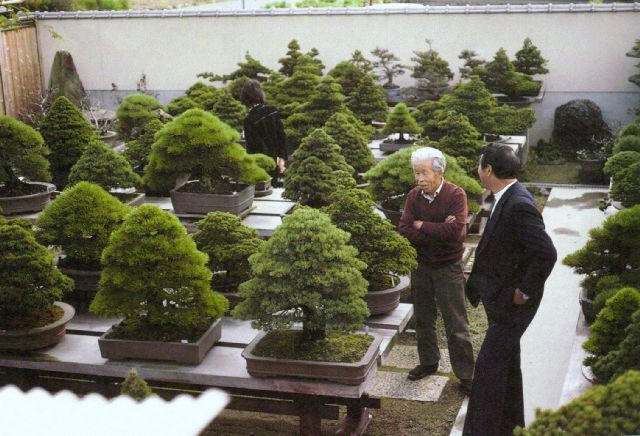
"Saichi Suzuki left, and Mikio Oshima discussing Pine bonsai in [Suzuki]'s garden in Okazaki, Japan.
("Zuisho, Part 1" by Saichi Suzuki, International Bonsai, 1986/No.1, pp. 18-19, "About the Author"
and "Zuisho, Part 2," 1986/No. 2, pg. 18; "Zuisho, Japanese Five-Needle Pine In America - Part 1" by
Julian R. Adams, 2013/No. 1, pg. 24; Nihon Bonsai Kyokai Bonsai Masterpieces, 1972, English,
pp. 45, 47) SEE ALSO: May 14, May 20, Dec 11
Mr. Suzuki has one of the finest private collections of Pine bonsai." (International Bonsai, 1988/No. 3, pg. 23) 2008 -- Nestled in a woody dale at Castle Hill, New South Wales, the Koreshoff Bonsai Nursery closed their doors. Thus was ended an era in which Vita and Dorothy Koreshoff were instrumental in filling a niche market and making a huge contribution to bonsai as a meaningful hobby and interest in Australia. While offering a modest selection of stock plants, Koreshoff's specialized in offering both newly created and advanced bonsai. At the Koreshoff nursery "art" predominated. Well-styled trees were the offerings. The closing of their nursery, which had been up for sale for two years, was a significant event. (Born in 1909, Vitaly Alexander had had glimpses of a gardener taking care of a few penjing in the family's yard in Harbin, Manchuria. The family moved to Australia in 1928. The mother was very upset with the houses on stilts up in Brisbane and so, in an attempt to cheer her, Vita attempted a few dwarf potted trees within four years of their arrival. Mother was not impressed with that form of gardening, but Vita rose to the challenge. Growing bonsai at the time was a tremendous amount of trial and error as there was no information available in English and apparently no teachers -- Chinese or Japanese -- in the country. (Now, Dorothy Wellings, born in 1930, started working at a shop that did machine embroidery. It was the Koreshoff family's business and Vita was the owner. With his sister's assistance, he began courting Dorothy. They married in April 1949 and she, "Dot," then became interested in bonsai. Vita used to put out something called "Secrets," little ideas that he had about dwarf potted tree gardening, a lot of the things he had pioneered which he then shared through correspondence with people in New Zealand, England, and America. Some of the things which he pioneered people are still using today. He was also a prolific author of articles published by many journals around the world. (The first Koreshoff nursery was opened by Vita in 1951. (The Silver Bell Nursery, owned by Len Webber, also opened that year.) Their daughters, Deborah Ruslana and Ruslana Ludmila, also joined in with this love of bonsai. Deborah (b.1957) had her own benches with show quality trees at age 7. In 1965 they moved from Pagewood out to relatively undeveloped Castle Hill, where they bought four acres. At the time Dorothy was the only one home during the day because Vita was working at the University of NSW. He was head of the Fine Arts Department and instead of retiring at age sixty he continued there on to sixty-five. The Koreshoffs became a primary producer nursery with three-quarters of it the big shed nursery and the collection area. A lot of stock was growing in the ground. The trees were lifted up when Dorothy and Vita thought the plants were suitable for young bonsai and for older bonsai. (They formed the Bonsai Society of Australia Inc. in August 1965. (Dorothy has been its president since 1976.) The family was featured in an illustrated article in The Australian Women's Weekly early June 1969. In July 1970, Dorothy and Vita helped their friend, Mrs. Dawn Hughes, establish the Illawarra Bonsai Society as a local club in Gymea. That September the bimonthly Bonsai in Australia magazine was started by the Koreshoffs (through 1991). The Eastern Districts Bonsai Society was established in the 1970s by Dorothy and Vita. (The name was changed in 2003 to Sydney City Bonsai Club (SCBC).) In 1976 the Koreshoff Bonsai Nursery became the first authorized branch of the Nippon Bonsai-Saikei Institute outside of Tokyo. In March of that year the couple also advised and helped birth the Newcastle Bonsai Society. Bonsai: Its Art, Science, History and Philosophy was written by daughter Deborah and published in 1984. It has since sold over 50,000 copies worldwide and is an important reference book. She was a lecturer/demonstrator at the Bonsai Clubs International convention in 1980 (Honolulu, HI) and 1983 (Orlando, FL); and the joint BCI/ American Bonsai Society 1984 symposium in Seattle, WA. (When Vita died in 1985, Dorothy continued to run the nursery with the full support of Deborah and Deborah's husband, Kenneth Doble. They also maintained the Koreshoff collection, with many of the magnificent trees started from seed in the 1930s and 40s. The year 1985 also saw the reprint in paperback of Dorothy and Vita's 1983's Bonsai with Australian Native Plants (with another in 1992). Deborah demonstrated at the European Bonsai Association 1993 convention (Zoetermeer, Holland). Dorothy was a lecturer/demonstrator at the Association of Australian Bonsai Clubs Ltd. conventions in 1988 (Brisbane), 1990 (Adelaide), 1997 (Coffs Harbour), and 2000 (Sydney). Dorothy and Deborah co-demonstrated at the European Bonsai Association convention in 1992 (Luxembourg).) Since her induction into the world of bonsai, Dorothy had become a world authority on growing and styling bonsai and received an Order of Australia medal for her services to horticulture.) [When the nursery closed, Deborah would sell all her trees and give up bonsai after being heavily involved since the age of 7. This shy teacher would go on to artistic pursuits that did not require watering or styling. She would be "out of bonsai and not responding to queries." [In early August 2008, two styled landscape-size (about 2.5 metres high) Japanese black pines would be transferred to the National Bonsai and Penjing Collection of Australia in Canberra. The trees had been germinated from seed imported in 1951 by Vita and Dorothy, and were initially grown in sandy soil in a vegetable garden in the eastern suburbs of Sydney. They were lifted and moved to Castle Hill in 1965. [In 2009 Dorothy would be in the process of getting two books completed for publication: The Structural and Growing (Elements of) Bonsai and Art Principles: Structure and Design (The Underground Story). Some of the Koreshoff's history is gone over in detail during the second half of Ryan Neil's two-part July 2024 podcast conversation with Lindsay Farr, specifically mark 45:30 to 48:20.]
2023 -- Bigbrit "Big" Ashley Almström passed away at age 94 in her sleep shortly after midnight at her home in Stockholm, Sweden. (Born in Stockholm, she went to Bromma kommunala flickskola (Municipal Girls School, 1939-1968), then studied sculpture in the class of 1971 at Konstfack[skolan], the country's largest university college of arts, crafts and design, a two-year art-industrial day school and a three-year art-industrial evening school, supplemented with a two-year higher art-industrial school. Bigbrit then studied at Stockholm University. From 1971 to 1993 she was Byrådirektör at Barnombudsmannen, City Council Director at the Ombudsman for Children, a government agency tasked with promoting and advancing children's rights and interests in Sweden on the basis of the 1989 UN Convention on the Rights of the Child (CRC). Bigbrit started living with Brian Ashley in 1984, and they eventually married on May 11, 2011. (Bigbrit was considered the mother of Bonsai in Sweden and she welcomed many of the world's bonsai artists to her garden at their amazing house and studio in the centre of Stockholm. In 1986 the Swedish Bonsai Society (Svenska Bonsaisällskapet) was formed. Nineteen years later there were about 400 members scattered around the whole country and a quarterly paper, Bonsaibladet, was being published.) (Facebook post, Jan. 28, 2023 from Bigbrit's family; "Bigbrit Ashley Almström Facebook page; "Svenska BonsaiSallskapet Show and a visit to Bigbrit Ashley Almström," Bonsai & Yamadori from Tony Tickle, March 27, 2019; "Information About the Swedish Bonsai Society," https://web.archive.org/web/20050404090734/http://www.bonsaisallskapet.se/v3/english.asp) SEE ALSO: Sep 26 |
||||
| 29 | 1991 -- The remaining four postage stamps and a souvenir sheet of the series "Bonsai" (first half released Dec. 9, 1990) were issued by the Maldive Islands to commemorate Expo '90, International Garden and Greenery Exposition in Osaka, Japan. SEE ALSO: Jan 23, Feb 3, Feb 16, Mar 1, Mar 27, Mar 31, Apr 3, Apr 6, Apr 18, May 6, May 29, Jun 16, Jul 20, Aug 20, Aug 22, Sep 22, Oct 1, Oct 4, Dec 9. | ||||
| 30 |
1935 -- F. Chase Rosade was born in Allentown,
Pennsylvania.
[He would graduate in 1958 from Doylestown's
Delaware Valley College of Science and Agriculture with
a major in Ornamental Horticulture. In addition to a degree, he would take away a Japanese maple seedling he'd
find that last year on the campus of his alma mater. It would be his first bonsai. Two years later he
would wed Connie (Tokiwa) Ibara, a native of Japan who was raised and educated in the U.S. After working for
a few years as a landscaper, Chase and Connie would would begin a two-year trip by land from London to Calcutta,
and then fly to Japan in 1963. There, after discovering the wider world of bonsai via
Yuji Yoshimura's book, Chase for eight months would become an apprentice to Kyuzo Yoshida
of Nara, a respected bonsai artist and nurseryman who specialized in Japanese White Pines. "It was amazing," Chase
would say. "I could not get over these plants. I didn't speak Japanese. He didn't speak English.
We would communicate by gesture. He didn't say, 'Prune this way.' You would watch him prune and shape,
and you would learn by watching. I started by pulling weeds, screening soil, watering." Finally,
Yoshida would let Chase work on an overgrown tree. "A man came to the nursery and sat there all day,
watching me work on the tree, pruning, wiring to shape the branches. Once in a while, he nodded his head,"
Chase would remember. "Turned out it was his tree." [Slowly, he would become a bonsai master himself. Chase would further his studies with a comprehensive course in Bonsai and Saikei from Mr. Kawamoto, the innovator of container landscapes. Upon the Rosades' return to Doylestown, PA, Chase would begin teaching bonsai in 1968, and two years later would purchase 10 acres of land in New Hope, PA to inaugurate the Rosade Bonsai Studio. Since the early 1970s Chase would travel throughout the U.S. and Canada, South America, Europe and Asia teaching and demonstrating before hundreds of clubs and groups. Chase would exhibit his bonsai trees at the Pennsylvania Horticultural Society's Philadelphia Flower Show for more than the last three dozen years. He would travel the world for decades as a speaker/mentor at bonsai symposiums. At one, he would meet Solita D. Tafur of Cali, Colombia, a widow who would have founded the Latin American Bonsai Federation and would also be an international demonstrator and officer. They would marry. Both would run monthly, all-day bonsai workshops at home and teach at international gatherings of devotees. While Chase would rule the dozens of bonsai in his greenhouse, Solita would nurture the tropical bonsai trees that line the windows inside the family home. [In late June 2005, Chase would be in a serious accident when his tractor would tip on him during a turn. Twelve hours of surgery would be required to reconstruct his hip and care for other internal injuries; a week in the hospital would be followed by three in a transition facility before he could return home, still unable to put any weight on either of his legs for several more weeks. By the end of 2007, however, Chase would have been participating again in conventions, now in Indonesia, New Zealand and India as a judge and demonstrator. He would continue with that Japanese maple bonsai, now an 18-inch-high but fully-developed specimen some sixty years into its 100-year life span. (It would have been 30 feet tall if it would have been left protected and in the ground.) "A bonsai is never completely finished," he would say. "It's always changing. I enjoy working every day here. It's quiet, serene. I play classical music or jazz, and I lose myself for hours on end in trimming, pruning, shaping my bonsai trees." He would look around his greenhouse and smile. "And I'm still learning." He would be one of the participants in the Black Scissors Live Demo Around the World on 10th September, 2017. A truly awesome episode of the Bonsai Time Podcast from early June 2022 is a two hour and forty-one minute-long "The Story of Chase Rosade: The Humble American Bonsai Pioneer," plus this Bonsai Wire Podcast interview Michael Hagedorn and Kevin Faris conducted with Chase from December 3, 2024.] 
(Bonsai, BCI, September 1970, pg. 5)
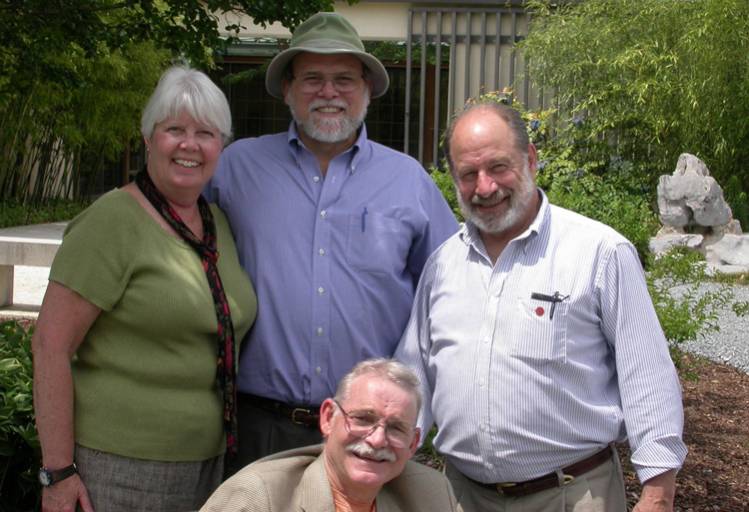
Mary Bloomer, Alan Walker, Chase Rosade, Vaughn Banting, 05/2003
(Photo courtesy of Alan Walker, 05/11/07) 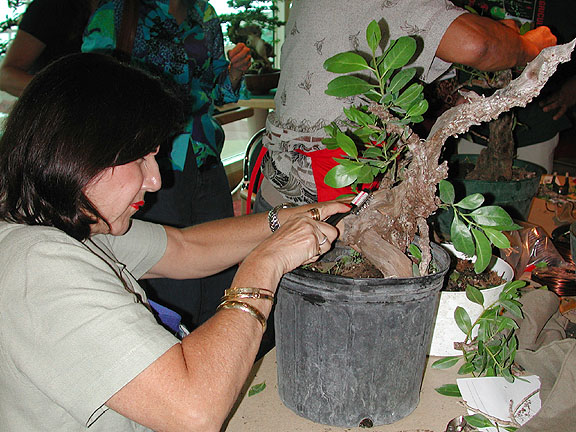
Solita Rosade with Mary Madison Buttonwood, 10/17/2001
(bio,
International Bonsai, 1986/No. 2, pg. 13;
Bonsai Magazine, BCI, March/April 1986, pg. 18; "Master Chase Rosade,"
http://www.mnbonsai.com/workshops/Chaserosade.html
; "Lectures and Demonstrations Biographical Information -- Chase Rosade,"
http://www.rosadebonsai.com/Lectures.html,
http://www.rosadebonsai.com/bios.html
; several postings on the
Internet Bonsai Club
beginning June 30; Geringer, Dan "Bonsai
master takes hobbit-size trees to Philadelphia Flower Show," The Philadelphia Inquirer, March 9, 2017)
SEE ALSO: Aug 31
(Photo courtesy of Alan Walker, 05/11/07) 1964 -- Premier Zhou Enlai paid a two-day friendly visit to Ethiopia. While there, Zhou gave the masterpiece penjing "Spring Fuchun" (Beimei) as a national gift to Emperor Haile Selassie I. (From 13 December 1963 to 5 February 1964, Premier Zhou and Vice-Premier Chen Yi toured ten African countries: the United Arab Republic (currently Egypt), Algeria, Morocco, Tunisia, Ghana, Mali, Guinea, Sudan, Ethiopia and Somalia.) This gifted Chinese sweet plum (Sageretia theezans) penjing with great branch ramification had been created by Lingnan master Kong Taichu. 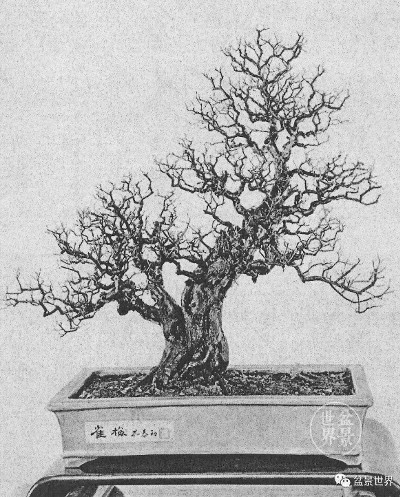
(Kong Taichu (aka K'ung T'ai-ch'u or Shao Yue, 1903-1985) had been born in Shangjia in Shandong Province (about 135 road miles northeast of the provincial capital of Jinan) and was the heir to the ancestral home of Shengmao Tea House in West Gate, Guangzhou (some 1800 km south/southwest of Jinan). He loved and studied Chinese calligraphy and painting since childhood and developed a hobby of collecting these. At the age of 19, he began to study Penjing, advocating the painting method. In the early 1930s, he had began to work on the research and creation of dwarfed potted tree art. At that time, the bonsai/penjing aesthetics of China as a whole were almost completely restricted by the aesthetics of traditional paintings and calligraphy. Penjing was more "technical" in its design with such regional forms as Yangzhou's "cloud film," Tongzhou's "two bends and a half," Suzhou's "six-three-three-top," Anhui's "You Longmei," as well as Sichuan's "three bends and nine turns." In Guangzhou, penjing enthusiasts were developing an interest in making "pictorial" penjing. Kong Taichu used the technique of first painting the ideal tree shape he sought and then he used that painting to guide him in producing his penjing. He often pasted a copy of the tree shape and captured the structure of the penjing shape through the projection. He had more than a hundred potted penjing in his home terrace. (Gradually, Kong Taichu began to study how to use the stumps dug from the mountains to become a "view" that has both artistic meaning and displayed natural growth laws. By chance, he was inspired by the tree shape of the old lychee tree. He found that after the annual picking of the lychee tree, it was pruned, so that the year-round pruning made the branches twist, the trunks were twisted, and the roots were tangled. The whole tree looks very vigorous. Therefore, he pioneered the method of "cutting and storing the branches," based on the beautiful trees grown by nature, and creating the pile embryos, like the method of "shrinking the dragon into the inch." These were then transplanted into large bonsai containers. This creative reform would transform the creation of Chinese dwarfed potted trees from the pursuit of craftsmanship to the pursuit of the natural phase of the teacher's law, and entered the creative thinking of "derived from and above nature." (In the early 1940s, in a charity exhibition in Guangzhou Watermelon Garden, Kong Taichu attracted a lot of attention with a large tree-shaped work and won the praise of the audience. Then from the 1960s, he began to study the elegant and artistic "painting tree," and incorporated into his own creation the "high-rise" style of another contemporary Lingnan bonsai master, Chen Su Ren (aka Su Jen or So-yan, 1895-1962, a Buddhist monk from the 10th century Haichuang Temple, aka Hoi Tong Monastery on Henan Island by the Pearl River in the Haizhu district in Guangzhou). This "towering trunk" form is characterized by clean emaciated trunks and branches, sparse but elegant foliage, and a refined stately profile that reflects transcendence of the secular world. At the same time, Kong still adhered to his "near-tree styling" approach, paid attention to the branching method and combined the rules of Chinese painting. (The research and innovation of Lingnan penjing art can be said to have started from Kong Taichu. He specialized in the production of "large tree" penjing which has a straight trunk, many branches, dense growth patterns, classic elegrance, a vigourous green hue, and the bold, free, lively appearance of a huge tree growing in the wilds. Also he created the double-dry type (aka twin trunk), kapok or "cotton type," and the "sea fishing moon type" (which was derived from the "cliff type" and became fashionably popular). He was one of the founders of the Guangzhou Bonsai Club in 1956 and its successor, the Guangzhou Bonsai Association in 1980. From the 1950s, many of his penjing works were selected as gifts for international exchanges to North Korea, Albania, Ethiopia and other countries. In 1956, he was elected as the director of the Guangzhou Potted Art Research Association. In 1957, the Guangzhou Municipal Government hired him to work in Yuexiu Park. He donated dozens of potted penjing to the park without compensation. [The book Ling nan p'en ching by Kong Taichu, Wei-chao Li and Yen-hsi Fan would be published in 1985.] 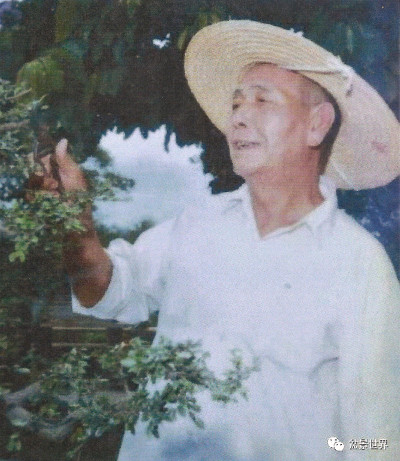
1965 -- The first Bonsai Clubs Association Convention was held at the Gallery of Flowers, Golden Gate Park, San Francisco. [In three years the BCA would be renamed Bonsai Clubs International.] ("Hindsight on BCI" by Tom Heitkamp, Bonsai Magazine, BCI, Jan/Feb 1978, pg. 4) SEE ALSO: Feb 28, Apr 16, May Also, Dec 30 |
||||
| 31 | 1960 - Chiyokichi Takahashi passed away in Berkeley, California. (His family would decide that one of the children should continue his bonsai nursery. Daughter Grace (1914-2005) and her husband Harvey Suzuki, who would have been graduated in agriculture, would decide to carry on, continuing as her father would have wished with a small backyard nursery for bonsai lovers.) (Chiyokichi Takahashi, Ancestry.com; Suzuki, Grace "A Tribute To My Father," Bonsai Journal, ABS, Vol. 9, No. 3, Fall 1975, pg. 66) SEE ALSO: Jan 10 |
